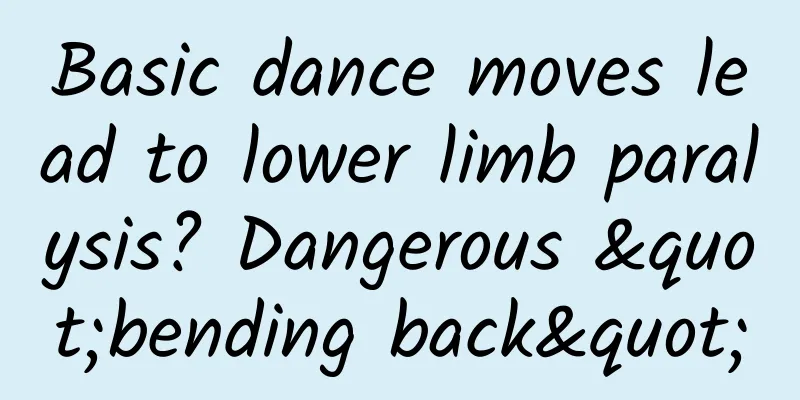Basic dance moves lead to lower limb paralysis? Dangerous "bending back"

|
|| || Written by reporter Lv Bingxin Photo and text editor: Chen Yongjie New Media Editor/Li Yunfeng Image Source/Visual China Interview experts: Wang Sanmei (Deputy Chief Physician, Department of Neurology, Department of Pediatrics, PLA General Hospital) Zhou Hongjun (Chief Physician of Spinal Cord Rehabilitation Department, China Rehabilitation Research Center) Li Beida (Associate Professor of Beijing Dance Academy) ▲Learning dance seems to have become the "standard" education for girls nowadays (Photo source: Visual China) Nowadays, learning dance seems to have become a "standard" education for girls, and many parents send their children to dance training institutions with the original intention of "exercise the body and shape the temperament". However, many parents do not understand that "bending the waist", a basic dance skill, is a dangerous action that may cause serious consequences. Earlier, CCTV's "Today's Statement" reported that a 5-year-old girl Dingdang had an accident while bending down during a dance class, which damaged her spinal cord and caused permanent lower limb paralysis. A female celebrity was also exposed that a girl's lower body was paralyzed due to improper bending down in a dance class run by her mother. ▲The program "A Childhood That Can't Stand Up" broadcasted by CCTV-1's "Today's Statement" tells the story of a 5-year-old girl named Dingdang who had an accident while participating in dance training, and suffered spinal cord damage, resulting in lower limb paralysis (Image source/CCTV screenshot) "Regret, pity, and heavy price paid" are the feelings expressed by almost all doctors when talking about children who become disabled due to backbending. "I hope that parents and dance training institutions can have a correct understanding of this dangerous move and pay attention to this potential risk." What are the risks of bending down? Can it really cause spinal cord injury? ◆ ◆ ◆ Nightmare: Paralysis caused by a low back sprain "Mom, when can I stand up?" Xiao Cai, an 8-year-old daughter sitting in a wheelchair, occasionally asks her mother Zhao Fang. On September 7, 2018, when Xiao Cai was bending down at home, she seemed to have twisted her leg accidentally. She thought it was nothing serious, but what happened next was beyond Zhao Fang's expectations. At first, the child just cried about leg pain, but within an hour, the child's legs could not move, he had no sensation, and he could not urinate or defecate. Realizing the seriousness of the situation, Zhao Fang took the child to a municipal hospital, and the doctor recommended going to Beijing or Tianjin. The MRI results of the examination in Tianjin showed spinal cord injury, and Xiao Cai "went directly to the intensive care unit and stayed in the ICU for 8 days." After that, Zhao Fang brought the child to Beijing to seek treatment from Wang Sanmei, deputy chief physician of the Department of Neurology, Department of Pediatrics, General Hospital of the Chinese People's Liberation Army. ▲The program "A Childhood That Can't Stand Up" broadcasted by CCTV-1's "Today's Statement" shows a 5-year-old girl named Dingdang attending a dance training institution (Photo source/CCTV screenshot) "Based on the MRI showing abnormal signal shadows of swelling and necrosis in the thoracic 7th and 8th segments of the spinal cord, Xiao Cai underwent a variety of related examinations, including lumbar puncture and cerebrospinal fluid and blood tests. After excluding various causes of spinal cord injury such as immunity, infection, and tumor, it was finally considered to be a spinal cord injury caused by the low back movement." Wang Sanmei told reporters that this situation is a spinal cord injury without fracture or dislocation caused by the low back movement, that is, there is no vertebral fracture or dislocation of the spine in the imaging examination. Because of this characteristic, it is easy to be missed or misdiagnosed. ▲Dingdang, sitting in a wheelchair, is still dreaming of standing up and learning to dance one day (Image source: CCTV screenshot) "I have treated about seven or eight cases of spinal cord injury caused by bending down. Some of them occurred in dance training institutions, and some occurred when practicing bending down at home." Wang Sanmei introduced that due to the abnormal stretching of the spinal countertension during the bending down movement, the spinal cord blood supply artery stretched and thinned, resulting in insufficient blood supply to the spinal cord, and even vascular endothelial strain to form thrombosis and blockage of blood vessels. The gray matter and white matter of the spinal cord nerves have poor tolerance to hypoxia, which will quickly cause segmental hypoxia injury to the spinal cord. The children experienced lower limb pain and movement disorders. Due to the weak compensatory ability of the spinal artery, collateral circulation cannot be formed quickly, and the spinal cord is hypoxic and necrotic, which can gradually involve 2 to 3 segments of atrophy, causing irreversible permanent paraplegia. ▲MRI photo of spinal cord injury (Photo courtesy of Wang Sanmei) "Paralysis - no feeling below the navel. I thought it was just a bone problem, but it turned out to be a spinal cord injury." Zhao Fang was struck by lightning when she thought about her young daughter having to spend the rest of her life in a wheelchair. In fact, in recent years, spinal cord injuries in children caused by dancing movements have become common, gradually attracting the attention of domestic doctors. In a paper published in 2020 titled "Changing Characteristics of the Causes of Spinal Cord Injury in Children", Zhou Hongjun, chief physician of the Spinal Cord Rehabilitation Department of the China Rehabilitation Research Center, was the corresponding author. A retrospective analysis was conducted on the causes of injury and demographic characteristics of children under the age of 14 with spinal cord injury admitted to the China Rehabilitation Research Center from January 1, 2015 to December 31, 2019. The study pointed out that there were 221 children with spinal cord injury, including 62 boys and 159 girls; they were distributed in all age groups from 1 to 13 years old, with a median of 6 years old; the largest number of children aged 4 to 7 years old (55.7%), mainly girls (83.7%). The top five causes of spinal cord injury in children were sports injuries in 78 cases (35.3%), non-traumatic injuries in 56 cases (25.3%), other injuries in 48 cases (21.7%), traffic accidents in 24 cases (10.9%), and falls from heights in 12 cases (5.4%). Among the cases of sports injuries, 75 cases (96.2%) of spinal cord injuries were caused by bending back movements, mainly occurring in children aged 5 to 7 years old (80.0%), all of which were thoracic spinal cord injuries without fracture or dislocation, of which 53 cases (70.7%) were complete spinal cord injuries. (Data source: "Characteristics of changes in causes of spinal cord injury in children") A noteworthy phenomenon is that Zhou Hongjun found that the number of children suffering from spinal cord injuries in the lower back decreased in 2021. "It is related to the epidemic. Because of the epidemic, offline dance training has decreased," Zhou Hongjun told reporters. However, many parents, including Zhao Fang, do not understand: Why can a simple movement of bending down cause such serious consequences? ◆ ◆ ◆ Follow-up question: How did the tragedy happen? Such voices of confusion and doubt are not uncommon on the Internet. On a short video platform, in videos of children bending their backs released by some dance training institutions, sometimes you can see these five or six-year-old children with red faces and clenched teeth in pain. Some netizens kindly reminded: If you practice like this, if you get spinal cord damage, you will get high paraplegia. But then there were a lot of rebuttals: I practiced like this when I was a child and there was no problem at all. There is no need to worry about children's soft bones. Acrobatics and martial arts are also like this. What's wrong with that? So, what's wrong? ▲A martial arts training institution lets children of a few years old do waist bending exercises (video screenshot) Zhou Hongjun told reporters that the mechanism by which bending down causes spinal cord injury in children is still not very clear, but the incidence of spinal cord injury caused by bending down has been on the rise in recent years and requires more attention. In addition, the incidence of spinal cord injury in children in my country is significantly different from that in other countries. Most studies abroad believe that there is no statistical difference in injuries between genders before the age of 3, but after the age of 3, the number of spinal cord injuries in boys is significantly higher than that in girls because of their hyperactivity and tendency to engage in dangerous activities. This is not the case in my country. Literature reports that girls are the main victims of sports-induced spinal cord injuries, and most of them are injured while practicing dance movements. According to foreign reports, the cervical spinal cord is a high-incidence area for children without fractures or dislocations, and the upper cervical segment is more susceptible to involvement; thoracic and lumbar spinal cord involvement is rare. In contrast, thoracic spinal cord injuries are more common in my country. ▲Schematic diagram of spinal cord injury In fact, this is indeed the case. Data from the China Rehabilitation Research Center provided by Zhou Hongjun show that in 2015 and 2016, the leading cause of spinal cord injury in children was non-traumatic injury; in 2017, sports injuries and non-traumatic injuries tied for first place; starting in 2018, the number of sports injuries exceeded non-traumatic injuries and became the first; in 2019, the number of sports injuries continued to rise, exceeding half of the total number of children with spinal cord injuries that year. Among them, the number of children with spinal cord injuries caused by dancing waist bending movements showed a clear upward trend. Some say the reason is that when children practice bending down, their thoracic spine is extremely hyperextended and the spine and spinal cord are over-stretched. However, due to the characteristics of children's growth and development, the elasticity of the spine is much greater than that of the spinal cord (possibly up to 9 times that of the spinal cord). The spine will not cause damage when stretched to a certain extent, but a slight stretch on the spinal cord can easily cause damage to the blood vessels entering the spinal cord, leading to spinal cord injury. Some people also believe that it may be related to fibrocartilage embolism. The movement of bending down can damage the intervertebral disc and the existing blood vessels in the intervertebral disc of young children, causing myxoid fibrocartilage emboli to enter the central spinal artery and spread retrogradely, causing spinal cord ischemia, thereby causing spinal cord injury. Children's body structure is not fully developed and has poor stability, which is also a factor that makes them prone to spinal cord injuries. Then why is it that some children are fine when they bend down, but others suffer tragic consequences? Zhou Hongjun said that not every child who practices bending down will have an accident, but it is indeed a risky action. Once a child sprains or falls while bending down, the possibility of spinal cord injury is very high. "Falling down while bending down is not the same as falling down while walking. The rate of spinal cord injury is much higher, so not all children are suitable for practicing this action." Zhou Hongjun emphasized. Wang Sanmei said that the anterior spinal artery is very fragile, and the most common injury caused by bending back is the anterior spinal artery in the thoracolumbar segment. "It is said that sometimes it is a case of inch force, but it cannot be ruled out that the child's spinal artery may have congenital malformation or abnormal distribution and course, causing some children to be intolerant of bending back movements. Spinal artery angiography can reveal abnormalities in the spinal blood vessels, but it is rarely checked." ◆ ◆ ◆ Nursing: The child is only 4 years old, what should I do in the future? Limb paralysis, incontinence... As you can imagine, children with spinal cord injuries face many practical difficulties in going to school. Xiao Cai was less than 4 years old when the accident happened. "Now she is in the first grade and goes to school in a wheelchair. We pick her up and drop her off every day," said Zhao Fang. Since Xiao Cai lost her ability to defecate on her own, this became the first problem she had to deal with during her studies at school. Zhou Hongjun introduced that, in fact, urinary tract infection is one of the most common complications after spinal cord injury in children. Long-term indwelling of a urinary catheter can induce urinary tract infection and bladder stones, and compressing the lower abdomen to urinate can cause problems such as hydronephrosis. "Before school in the morning, around 7 o'clock, I will help her catheterize at home. She arrives at school at 7:40. After arriving at school, I will tell her to drink less water, not too much. After school at 11:40, she will go home and catheterize again. The process is probably the same in the afternoon." Zhao Fang worries about Xiao Cai's daily life day after day. In addition, unlike spinal cord injuries in adults, children with spinal cord injuries often suffer from scoliosis and hip joint abnormalities because the growth and development of the skeletal system is affected. Zhou Hongjun told reporters that almost all children with spinal cord injury will have scoliosis. Studies have shown that compared with the injury segment, degree, and motor function level, age is a key factor in predicting scoliosis in children with spinal cord injury. The risk of scoliosis in children under 12 years old is 3.7 times that of older children. Severe scoliosis may affect breathing, visceral function, and even fertility problems. Therefore, parents and children must pay special attention, focus on exercise, and use professional wheelchair braces, insoles, and other auxiliary prevention methods. ▲ Spinal cord injury rehabilitation Xiao Cai also needs her parents' care at all times when she sleeps at night. "She needs to be turned over every few hours. Because Xiao Cai's lower limbs cannot move independently, but her upper body can, Xiao Cai often sleeps 'twisted' and needs help to turn her over." The physical pain and discomfort are obvious, and the psychological torture of endless helplessness on parents and children also needs to be seen. "Xiao Cai seems to be OK on the surface, but she used to be very outgoing, but now she won't talk to other kids at school. She also becomes very impatient and loses her temper easily and can't control it," Zhao Fang said, summarizing the changes in her daughter after the accident. "I think it has something to do with this disease." Zhao Fang admitted that she still cannot accept this reality. "I wish my daughter could be as healthy as other children of the same age." Wang Sanmei's many years of observation and experience in treating patients show that parents are almost desperate when they first learn about the disease, so psychological counseling is very important for both parents and children. "If parents can fully help and guide their children, most children will be relatively optimistic." However, it is undeniable that some children will have some psychological problems. Subsequent rehabilitation in the hospital usually takes 2-3 months. Zhou Hongjun said that in addition to motor rehabilitation training for children, the rehabilitation process also includes training in daily living skills, such as how to defecate, use a wheelchair, use a brace, and dress yourself. In comparison, nursing at home after discharge is a longer process. But whether it is the child's medical treatment, rehabilitation or daily care, it requires material investment, which is a heavy burden for Zhao Fang, who lives in the countryside. "Anti-scoliosis wheelchair costs 8,500 yuan, anti-bedsore cushion 1,000 yuan, and the initial rehabilitation cost is about 10,000 yuan per month..." As the child grows up, the wheelchair and brace need to be replaced, and the accumulated costs make Zhao Fang feel stressed. "We understand that compared with rural Hebei, developed cities like Shenzhen have many people-friendly policies for children with spinal cord injuries. We hope that at the social level, there will be more help or subsidies for families like ours." Zhao Fang said. ◆ ◆ ◆ Question: Can children still dance happily? "I joined the group in 2018. At that time, there were about 200 people in the group. Now there are nearly 400 people." After her daughter got sick, a fellow patient pulled Zhao Fang into a group of children with spinal cord injuries. "Most of them are children with spinal cord injuries caused by bending back, and there are also some cases caused by other accidents." The patients in the group communicate every day, discussing the children's condition and other symptoms, and some parents will share their experiences with others. What is recorded in the WeChat group may seem to be just an introduction to each child's condition, but in reality it is also a reflection of the parents' torment and anxiety, and even more so, the fate of each child. These messages constantly remind us that we must pay attention to the safety hazards behind the back bending action. The reporter found through Tianyancha that there are as many as 11,607 dance institutions that have been established for only one year. Whether in cities or rural areas, learning dance has undoubtedly become an educational choice for more and more girls. A retrospective analysis of children with spinal cord injury treated by the China Rehabilitation Research Center showed that most of the children came from private dance training institutions in economically and educationally underdeveloped areas, and dance teachers often lacked professional training. Zhou Hongjun suggested that in order to prevent spinal cord injuries caused by children bending down, it is best to evaluate the children in advance to see which children are suitable for practice and which are not. Children who are too young are not suitable for bending down. The choice of dance school is also critical. Formal dance schools and dance teachers rarely let very young children practice bending down. After a certain age, they may be able to practice slowly. "For example, the child of a friend of mine practices dance in the Children's Palace, and he rarely bends down before he is 10 years old." ▲Experts believe that physical assessment of children and selection of formal training institutions and teachers are important steps to prevent accidents. Li Beida, an associate professor at the Beijing Dance Academy, holds the same view. Physical assessment of children and choosing formal training institutions and teachers are important parts of preventing accidents. "Those dance training institutions in society that have no professional training and just start classes after a few days of training are more likely to have problems." Li Beida mentioned that in order to prevent children from bending over and suffering spinal cord injuries, what is most needed now is experienced and qualified professional teachers to give some public welfare classes and cultivate parents and dance teachers to have scientific methods and understanding on the issue of bending over. "It is undeniable that there are definitely some fake dance training institutions nowadays." Li Beida made a pertinent suggestion. If you want your child to specialize in dance, wait until the child is old enough and send him to a professional school for formal and systematic training. Parents should not rush to send their 5 or 6-year-old children to institutions to do waist and splits. If they are not trained well, it will not only affect the height of the children, but also may ruin their bodies. "For 5 or 6-year-old children to learn dance, the main thing is to cultivate their interest. The teacher can accompany them to dance, play and have fun. There is no need to practice hard at such a young age." ◆ ◆ ◆ First aid: What should I do if a spinal cord injury occurs after bending down? Wang Sanmei told reporters that among the young patients she has seen, some could not move after bending down, but there were also those who gradually developed various symptoms. "At first, it might be pain in one leg, then it might develop to pain in both legs, then it develops to inability to urinate or defecate independently, and finally it is found that there is no sensation below the injured part and the person cannot move." But basically all symptoms will appear within 12 hours. Zhou Hongjun reminded that the child may just have leg or back pain at first, and when the teacher asked the child to try to stand up and move around, he or she was able to walk normally. If the dance teacher does not have a sense of safety risks, he or she may mistakenly think that the child is fine and may continue to practice, which is very dangerous. "After many children got into trouble, parents also checked the surveillance of the dance training institution and found that the teacher still asked the child to continue to do some movements, which may aggravate the injury." Zhou Hongjun stressed that it is necessary to remind parents and dance teachers that if a child falls while bending down while dancing, they must not continue the activity. Regardless of whether the child can continue training at the time, they should be observed for a day or two to confirm that there is no problem before continuing slowly. ▲Correct rescue methods for spinal cord injuries || || What should we do if something really goes wrong? Zhou Hongjun concluded that we should go to an experienced hospital for treatment as soon as possible, the sooner the better. Because not all hospitals and doctors have treatment experience, especially in some rural areas, doctors have no experience and think that there is no fracture or dislocation of the lumbar spine, so they let the child go home for observation, delaying the child's treatment time and causing some unnecessary losses. When experienced professional doctors carefully inquire about the medical history, if they find that the child has bent back, they will immediately be alert. Wang Sanmei said that almost no parents and dance teachers can recognize the danger signals in time. "If it is discovered early, treated promptly, and immobilized and thrombolytic therapy are taken in time, it may be saved and the spinal cord injury can be reversed. But unfortunately, in similar cases I have come across, no one can seize this opportunity in time." "It is also necessary to do active and passive exercises to maintain the volume of lower limb muscles after paralysis. We look forward to the popularization of human-machine intelligent rehabilitation limbs in the near future to benefit these children and help them stand up and walk," said Wang Sanmei. In fact, the medical community's understanding of spinal cord injury without fracture or dislocation caused by lower back pain did not come overnight. Zhou Hongjun, who has been working on the front line and engaged in spinal cord injury rehabilitation for many years, said that his understanding of this disease probably began in the 1990s, and it was not until the late 1990s to around 2020 that he basically had a clear understanding of this issue. "In the past, many diagnoses were myelitis. It was only after continuous summarization that we came to a correct understanding." Zhou Hongjun believes that actively exploring the truth of the disease and putting forward professional opinions based on facts will be fair to everyone when it comes to compensation issues. (Note: To protect the privacy of patients and parents, Xiao Cai and Zhao Fang are pseudonyms in this article) Produced by: Science Central Kitchen Produced by: Beijing Science and Technology News | Beijing Science and Technology Media Welcome to share to your circle of friends Reproduction without authorization is prohibited |
<<: World Hemophilia Day丨Care for "glass people", forward for love!
Recommend
Providing offline support for mobile apps
Offline support for mobile applications can be un...
Foshan mini program production and customization development, what are the processes for developing a mini program?
After the fifteenth day of the first lunar month,...
Sword pointing to offer data structure and algorithm
Brief introduction to offer data structure and al...
Take the initiative in your career: build your personal brand and let opportunities come to you
Course Catalog: 01 Make sure what you earn is wor...
[Smart Farmers] Focus on Document No. 1丨“Operation Manual” for Comprehensive Rural Revitalization: Keep the Bottom Line, Promote Revitalization, and Strengthen Guarantees
[Smart Farmers] Focus on Document No. 1丨“Operatio...
Is there a chance that Coolpad, which has “nothing, no reputation”, can get on board with 360?
At the end of the year, the mobile phone industry...
Refined operation strategy for users with repurchase rate of over 95%
What I want to share today is the refined operati...
Audi and Hyundai join forces to help the auto industry break away from the era of each taking care of its own business
Recently, foreign media reported that Audi announ...
Lei Jun's interview with the audience: Xiaomi's boundaries, vision and challenges
December 17 was the day after Lei Jun’s 45th birt...
BYD responds to the collision result of the Dihan EV, suspecting that the car was tampered with
Recently, the automotive media DoCar.com released...
Guangzhou Jimifeng Network Technology Co., Ltd.
Guangzhou Jimifeng Network Technology Co., Ltd. G...
Baidu bidding promotion keyword ranking query method, a must-learn for novices!
For bidders, after setting the bid, the most impo...
[Chasing Dreams among Stars] Zhang Xuan: Solving the Simulation Problem to Build a "Heart" for Satellites
Your browser does not support the video tag This ...
How to obtain seed users during cold start?
In my previous company, I was involved in product...
"China's Sky Eye" has discovered more than 800 new pulsars and entered a period of explosive growth →
The reporter learned from the FAST Operation and ...









